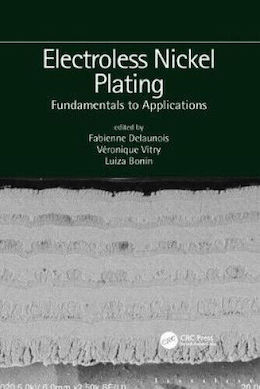
-----
Plating a component comprised of both both plastic and steel
by Fabienne Delaunois et al

on eBay or Amazon
or AbeBooks
(affil link)
by American Society for Electroplated Plastics

on eBay or Amazon
or AbeBooks
(affil link)
Q. Hi,
I am doing electrolytic and electroless plating for one of my projects. I have a few questions listed below. Hope you can help me out.
1. I'd like to do electroless Cu or nickel plating on plastic materials ( such as epoxy). Where can I purchase activator for plastic surface? Could you please provide me phone number and even product name?
2. On my substrate, I have both plastic and metal surface, what kind of activator I can use to activate both of surfaces so that electroless Cu (or Ni) plating can work? Will Pd/Sn activator work for metal surface too?
3. One of my projects requires mirror finished Ni plate (it can be Ni alloy). The thickness is around 20 mils. Do you know any vendors who provide those plates or any vendors provides this polishing service?
I sincerely appreciate your information and assistance on those questions.
Thank you so much.

Johnson Chiang,_PhD
University of California, Irvine - Irvine, California
2002
A. The traditional way of preparing polypropylene, ABS, and plateable grades of nylon and fiberglass for the highest quality (highest adhesion) plating, for such things as automotive grills and lamp bezels, is indeed to use palladium activators and tin salts followed by electroless nickel. I do understand that there is some movement away from that these days towards direct plating after graphite or similar metallization
But these processes are proprietary--people buy all of the preplate process steps from a plating chemical vendor like
Technic, Macdermid, or Atotech. The steps will start with an etch to give the plastic some tooth, and may include other steps besides palladium chloride activation, such as immersion in a separate tin salt. Then you apply electroless nickel or sometimes electroless copper, using the palladium as the 'seed' to start the process.
I am not aware of real applications which mix plastic and metal parts, but in theory it should be doable because steel (assuming that's the metal) is catalytic for electroless copper and nickel.
Another way to plate on non-conductive surfaces is to spray a two-part silvering solution on it (silver nitrate
⇦ on
eBay or
Amazon [affil link]
plus a reducing solution). Then you can electroplate (starting with a very low current to not burn the silver). This method is not usually used on rough-service items like automobile exteriors because it doesn't have as good adhesion. But this may be good enough for your application, and it may be more suited to mixing plastic and metal (as I say though, I don't have any real knowledge of anyone trying to plate a component of both plastic and steel).
You can check our Jobshops Directory for shops that do polishing; or hopefully one of our advertisers who polishes nickel or offers polished nickel will contact you. Another possibility is to contact an electroforming service like NiCoForm [a finishing.com supporting advertiser] and have them electroform exactly what you need.

Ted Mooney, P.E.
Striving to live Aloha
finishing.com - Pine Beach, New Jersey
Ted is available for instant help
or longer-term assistance.
Q, A, or Comment on THIS thread -or- Start a NEW Thread
